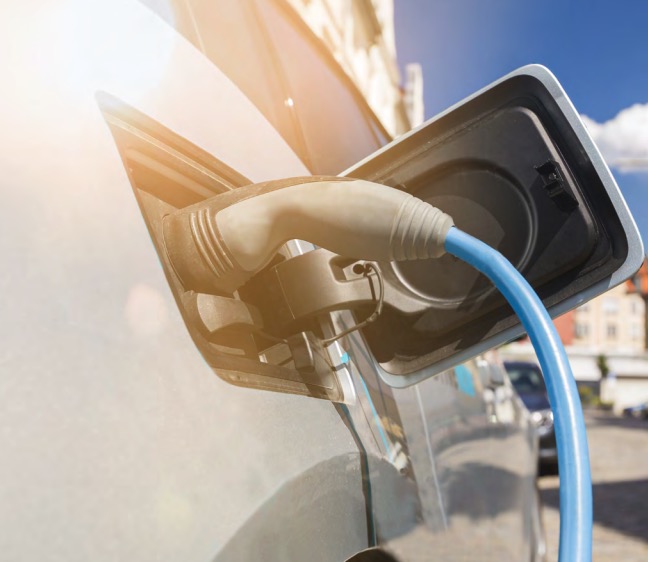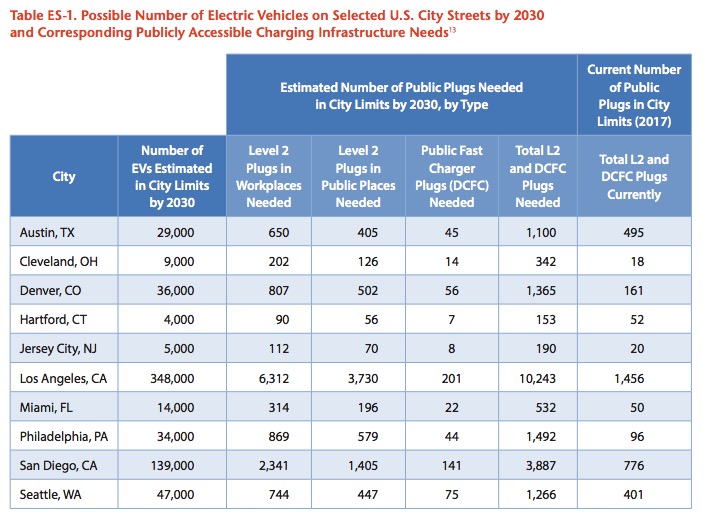U.S. PIRG EDUCATION FUND
FRONTIER GROUP
ENVIRONMENT AMERICA
 The adoption of large numbers of electric vehicles (EVs) offers many benefits for cities, including cleaner air and the opportunity to reduce greenhouse gas emissions. Electric vehicles are far cleaner than gasoline-powered cars, with lower greenhouse gas emissions and lower emissions of the pollutants that contribute to smog and particulate matter.
The adoption of large numbers of electric vehicles (EVs) offers many benefits for cities, including cleaner air and the opportunity to reduce greenhouse gas emissions. Electric vehicles are far cleaner than gasoline-powered cars, with lower greenhouse gas emissions and lower emissions of the pollutants that contribute to smog and particulate matter.
The number of EVs on America’s streets is at an all-time high. Throughout 2016, sales of plug-in electric vehicles increased nearly 38 percent.2 In 2017, sales of electric vehicles were up again, increasing 32 percent over the year.3 The introduction of the Chevy Bolt, Tesla’s Model 3 and other affordable, long-range electric vehicles suggests that growth in EV sales is just beginning. In fact, Chevrolet’s Bolt EV was named Motor Trend’s 2017 Car of the Year.
But with more EVs on the road, and many more coming soon, cities will face the challenge of where electric vehicles will charge, particularly in city centers and neighborhoods without off-street residential parking.
The good news is that smart public policies, including those already pioneered in cities nationally and internationally, can help U.S. cities lead the electric vehicle revolution while expanding access to clean transportation options for those who live, work and play in cities.
Electric vehicles are poised for explosive growth.
Technological gains that allow electric vehicles to drive farther, charge faster, and be produced more affordably are revolutionizing the vehicle market. With adequate policy and infrastructure investments, Bloomberg New Energy Finance estimates that, globally, more than half of new cars sold by 2040 will be electric vehicles.
Types of Electric Vehicle Charging InfrastructureThere are three primary types, or levels, of electric vehicle chargers – Level 1, Level 2 and DCFC (often referred to as “fast charging”).
- Level 1 charging is from a standard wall outlet and provides a slow charge, adding 4 to 5 miles of range per hour. Therefore, with a Level 1 charger, an empty EV battery may need to charge for 10 hours to get 50 miles of range. Level 1 chargers can work well for at-home charging, where EV owners park overnight, and in many workplaces, since the typical commute in many metro areas is less than 10 miles each way. Because Level 1 charging requires only a standard three-prong outlet, it is often the most affordable way to offer charging, with minimal installation costs.
- Level 2 chargers require special installation but can charge an electric vehicle battery 2 to 6 times faster than a Level 1 charger, adding 12 to 25 miles of range per hour of charge, so 50 miles can be added in 2 to 4 hours. If people install a charger in front of their house, in their driveway, or in their garage, it is most likely a Level 2 charger. In public spaces, such as parking lots or on public streets, most chargers are Level 2, allowing EV drivers to charge their car for a few hours while at work or shopping. Level 1 and Level 2 plugs are standard in the United States so all EVs can charge at those charging stations.
- Fast chargers, known as DCFC (for direct current fast charge), can add 100 miles of range or more in an hour of charging – meaning an EV driver can add 50 miles to their battery in just half an hour. Different EV makes and models are compatible with different fast chargers and may require an adaptor to charge. Fast chargers will be especially important for long-distance travel when drivers won’t be stopping for hours at a time, so DCFC chargers work well at rest stops and gas stations off highways and are important for the viability of electric shared mobility services, whose vehicles may be used for many trips – and travel many miles – in a given day. However, only pure battery electric vehicles can use DCFC charging, so it excludes plug-in hybrid EVs.
This report recognizes the value of Level 1 chargers as a low-cost option at homes, workplaces, and some public parking areas (like airports), but focuses on Level 2 and fast charging (DCFC) for public spaces, which are the chargers you would expect to find curbside, at workplaces and businesses, in parking garages and in other public areas.
Cities need to be ready for an influx of electric vehicles.
In a few short years, tens of thousands of electric vehicles could hit city streets across America, from Portland, Maine, to Portland, Oregon. Yet, as of now, most cities are unprepared for this pending influx. These vehicles will need a place to charge, so public access to EV charging stations will be critical, especially since only about half of vehicles in the U.S. have a dedicated off-street parking space, like a driveway or garage.
Major cities will require the installation of hundreds to thousands of publicly accessible electric vehicle chargers in order to serve the increased demand for electric vehicles. Studies conducted separately by the National Renewable Energy Laboratory, the Electric Power Research Institute, and Pacific Gas & Electric estimate that 1-5.2 public fast chargers are needed to support 1,000 electric vehicles.8 The National Renewable Energy Laboratory estimates that 36 non-residential Level 2 chargers are necessary for every 1,000 electric vehicles.9 Cities will also need to facilitate at-home charging since the majority of EV owners will need to park and charge their vehicles overnight at or near where they live.
The world’s leading EV cities have adopted key policies that enable urban residents to own and operate electric vehicles. In particular, these cities have been able to deliver electric vehicle infrastructure to urban drivers through innovative parking and planning policies, including:
- Residential access to on-street EV charging: Many residents, particularly in large cities, do not have access to an off-street parking spot where they might charge their electric vehicle overnight.14 Cities around the world are tackling this problem with innovative solutions to install or incentivize residents to install on-street charging infrastructure at curbsides in dense areas. For example, residents in London can ask the city to install, and mostly pay for, EV charging infrastructure at streetlights on their block.
- Access to public charging stations: By acting directly or partnering with other entities – such as private garages, public schools and community centers – cities can ensure that there are adequate parking spaces for people to charge their EVs when they aren’t at home, for instance, while they are commuting, shopping or traveling.
- Support for private investment in publicly accessible stations: “Semi-public” stations can provide EV owners a place to charge at privately owned stations at businesses, parking garages or private driveways. By incentivizing the installation of shared charging stations, cities can optimize use of charging infrastructure.
- Incentivized EV parking and charging: Some cities have local government programs or agencies that offer discounted or free charging and parking for electric vehicles in public spaces. Electric vehicle charging port on a lamppost in London. Photo: Jason Cartwright via Flickr, CC BY 2.0. Leading cities are encouraging shared mobility options and reforming parking policies to expand access to electric vehicle travel and reduce conflicts over parking.
- Carsharing services are expanding access to EVs – and to EV charging – around the world. Fleets of shared electric cars, like BlueIndy in Indianapolis, allow people to drive electric vehicles without needing to personally own one. These services can also expand public access to EV charging by opening up their charging infrastructure for the public to use.
- Expanding shared mobility, electrified public transit, safe biking and walking and other transportation options – as well as implementing parking reforms – can reduce competition for on-street parking that might crowd out space for EV charging.
Electric vehicles are an essential tool for cities to combat global warming and air pollution, and offer consumer benefits like lower fuel costs. Technological developments mean that EVs are poised to hit the market in record numbers. However, there is a lot left to be done. If cities fail to develop comprehensive plans for EV charging now, they risk being unprepared for large numbers of EVs hitting local streets in coming years.
In order to be successful, cities will need to develop comprehensive solutions to accommodate electric vehicles, including convenient opportunities for charging. Some specific strategies include:
- Expanding access to electric vehicle charging for residents without off-street parking, by dramatically increasing the number of charging stations in residential areas.
- Partnering with businesses and public entities (like schools, community centers and municipal offices) to use their existing parking infrastructure while providing EV charging.
- Facilitating and encouraging electric shared mobility options like carsharing, ridesharing and bikesharing.
- Directing municipal utilities to install charging infrastructure and coordinating closely with investor-owned utilities to maximize opportunities.
- Considering a demand-based and shared system for parking.
Download full version (PDF): Plugging In
About the U.S. PIRG Education Fund
uspirgedfund.org
U.S. PIRG Education Fund is an independent, non-partisan group that works for consumers and the public interest. Through research, public education and outreach, we serve as counterweights to the influence of powerful special interests that threaten our health, safety or well-being.
About the Frontier Group
frontiergroup.org
Frontier Group provides information and ideas to help citizens build a cleaner, healthier and more democratic America. We address issues that will define our nation’s course in the 21st century – from fracking to solar energy, global warming to transportation, clean water to clean elections. Our experts and writers deliver timely research and analysis that is accessible to the public, applying insights gleaned from a variety of disciplines to arrive at new ideas for solving pressing problems.
About Environment America
environmentamerica.org
“Through Environment America, you protect the places we love and promote core environmental values, such as clean air to breathe, clean water to drink, and clean energy to power our lives. With 29 state affiliates and members and supporters in every state, together we focus on timely, targeted action that wins tangible improvements in the quality of our environment and our lives.”
Tags: Electric Vehicle Charging Infrastructure, Electric Vehicles, Environment America, EVs, Frontier Group, U.S. PIRG Education Fund







 RSS Feed
RSS Feed